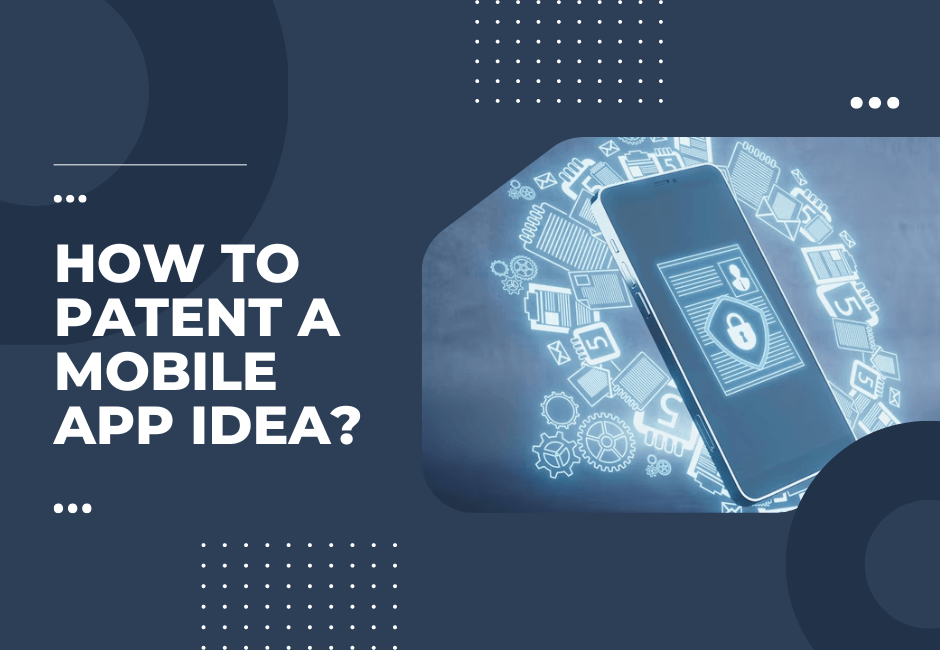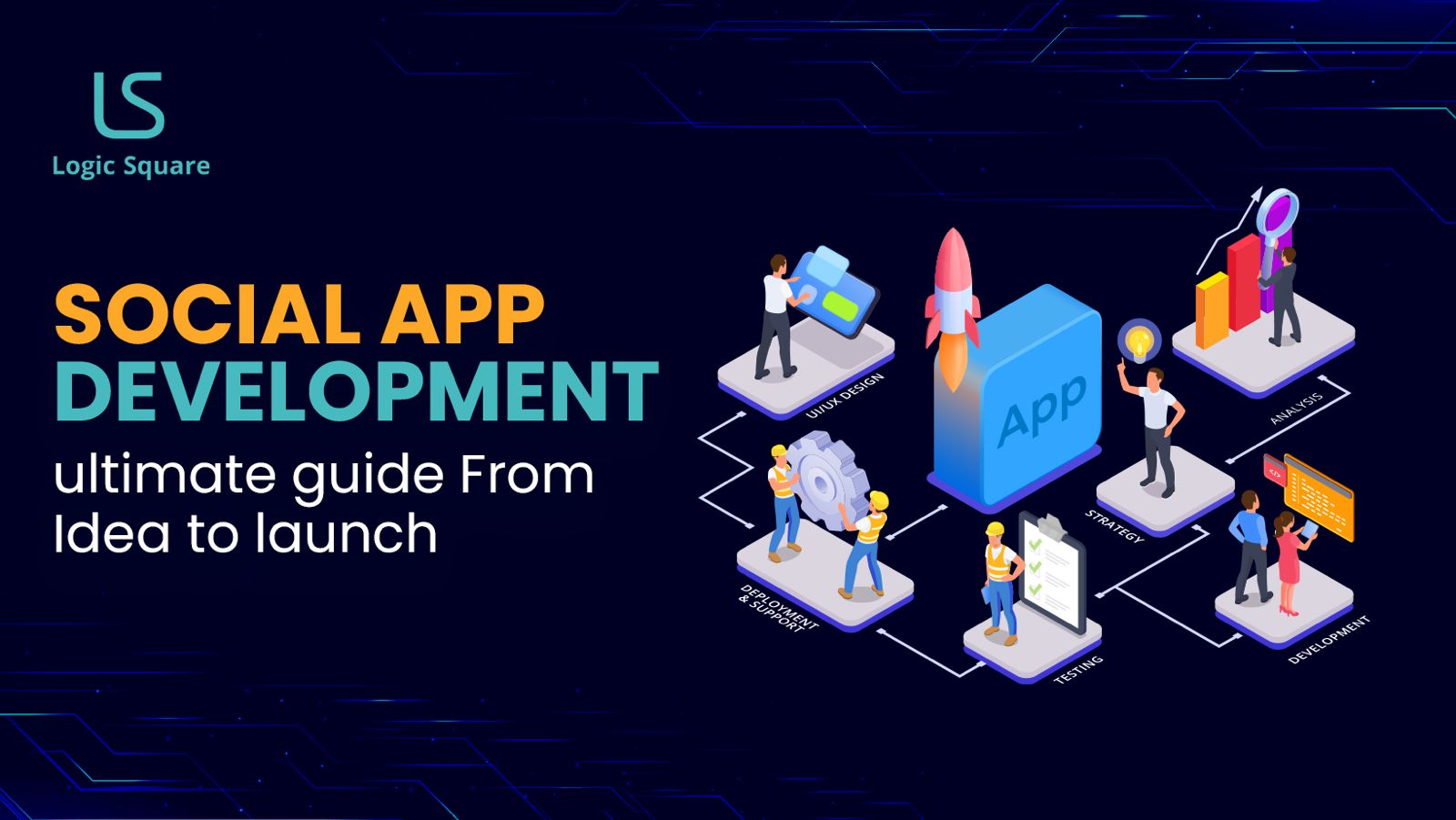The universe of mobile applications is becoming increasingly competitive, and the top mobile app development companies are fighting tooth and nail to safeguard their unique intellectual properties from competitors. With the rapid advancement of technology and the proliferation of mobile applications, protecting your intellectual property has never been more critical.
As of 2023, mobile applications saw the second-highest number of patent applications, driven by tech giants racing to create groundbreaking products. If you have a game-changing mobile app idea that could rake in millions, securing a patent is crucial—the delay could cost you big time. Are you wondering how to patent your mobile app idea? Stick around and consider this article worth reading to know everything you ever wanted to patent your mobile app idea.
Table of Contents
ToggleWhy Should You Patent A Mobile App Idea?
The question is, why should you patent an app idea in the first place? Well, there are a few key reasons why you might consider patenting a mobile app idea.
- Protection From Copycats: When you patent an app idea, you earn the legal right to prevent the unauthorized use of the UI/UX design, tech stack, and exclusive features of your mobile app idea. Patenting your app grants you legal ownership of its unique concept or functionality. By patenting your mobile app, you can prevent others from copying its unique features and design, safeguard its exclusive USP, and maximize your revenue potential. For instance, if your mobile app’s features or design elements are patented, any company wanting to enter that domain may have to buy that innovation from you. Plus, you can choose to withhold your groundbreaking innovations from competitors for an extended period.
- Competitive Advantage: A patent can give you a significant head start in the market. With exclusive rights, you control who can develop and sell similar apps for a limited time. For example, if Apple had patented its GUI concept, it could have legally prevented Microsoft from using and selling products based on that innovation.
- Attract Investors: A patent can make your app idea more attractive to potential investors. It showcases your effort to protect your intellectual property and have a serious business proposition.
- Potential for Licensing: In some cases, you may license your patented app idea to other companies in exchange for royalties. It can be a lucrative way to generate revenue from your concept.
Is Your Mobile App Idea Eligible For Patent?
We live in a mobile-driven world powered by the internet. Therefore, finding a unique and original mobile app idea can be challenging. Currently, there are over 9 million apps in both the Google and Apple stores, and the number is growing. So, even with an exciting and excellent mobile app idea, you should be very careful. How can you make sure your mobile app is eligible to file a patent? Let’s check out.
| Factor | Eligibility Criteria | Description |
| Invention | Must be new, useful, and non-obvious | The app idea must be novel (original and not already existing), solve a problem or offer a utility (be useful), and not be something an ordinary person with knowledge in that field would consider an obvious solution. |
| Functional Uniqueness | Focuses on the ‘how’ of the app, not the ‘what’ | A patent protects the unique functionality of the app, such as a novel process, algorithm, or method for achieving a specific task. The general idea or aesthetic design of the app is not patentable. |
| Geographical Location of the Idea | Irrelevant for patentability (copyright might apply) | Patent laws are territorial, so you would need to apply for a patent in each country you want protection in. However, the location where the idea is conceived is not relevant for patentability itself. Copyright might be relevant for protecting the creative aspects of your app, regardless of location. |
| Patent Laws | Varies by country/region, consult relevant patent office | Patent laws can vary depending on the country or region. It’s important to consult the relevant patent office or a patent attorney to understand the specific requirements for patenting a mobile app idea in your target market. |
Different Types Of Patent Applications You Can Use For Your Mobile App Idea
A patent is a type of intellectual property right, and there are primarily two types of patents, i.e., a) Utility Patent & b) Design Patent, which you can file for your mobile app idea. Now, let’s explore the various elements of a mobile application that you can file for a patent.
| Patent Type | Description | Useful Suggestion |
| Not Applicable | The whole concept of a mobile app can’t be patented, as patents are designed to legally protect tangible innovations instead of abstract ideas or concepts that have not been validated. | Focus on patenting the functional or visual execution of the concept. |
| Utility Patent | A novel method of communication between the app and a server, such as a unique data transfer protocol. | General server interaction wouldn’t be patentable. |
| Not Applicable | The structure of a database itself is not patentable. | You can potentially patent a unique method for storing or manipulating data within the database. |
| Utility Patent | A new and innovative way for devices to interact with each other through your app, such as a method for peer-to-peer data sharing. | Basic data exchange wouldn’t be patentable. |
| Possibly Design Patent | A highly unique and original layout for displaying information within the app. | Utility patents might be applicable for specific methods of presenting data (e.g., interactive charts). |
| Not Applicable | The use of a third-party server is not patentable on its own. | You might be able to patent how your app interacts with a third-party server for a specific purpose. |
| Utility Patent | A novel method of processing data on the server side that is triggered by the app. | General data processing wouldn’t be patentable. |
| Not Applicable | Established networking protocols are generally not patentable. | You might be able to patent a new way to use networking protocols within your app. |
| Utility Patent | A unique and innovative method for securing user data and authenticating logins within the app. | Common security measures wouldn’t be patentable. |
| Utility Patent | A novel way to identify and track users within the app, such as a method using biometric data (fingerprint, facial recognition). | Basic user identification (username/password) wouldn’t be patentable. |
| Utility Patent | A new and efficient method for sending data updates or notifications from the server to the app. | The basic concept of data pushing wouldn’t be patentable. |
| Utility Patent | A unique way for the app to handle user input and interact with the device’s functionalities. | General touch input processing wouldn’t be patentable. |
| Possibly Design Patent | The unique visual elements of the app, such as the layout, iconography, or animation style. | Focus on the originality and artistic merit of the design. |
Crucial Steps To Patent Your Mobile App Idea
So, how do you patent a mobile app? To patent your mobile app idea, you should remember the fact that it’s entirely a complex legal process. There are specific steps that you should follow to navigate it efficiently. Let’s explore them one after another.
#1 Consult An Experienced Patent Lawyer:
The protection of intellectual property rights involves a complex litigation process. You must present your entire mobile app concept in properly written form, defining everything from your app type, functionalities, features, and how they are unique. Therefore, you should find and consult an experienced patent attorney who understands the patent process in great depth. The patent attorney can help you achieve a hassle-free patent application approval.
#2 Choose The Patent Authority:
Each country has a dedicated legal body that monitors and approves patent rights for intellectual property. Policies, regulations, and procedures relating to patent filing may also differ from one country to another. Depending upon your business’s location and your mobile app’s target market, you should choose the authority responsible for processing and approving your patent claim. Let’s explore the patent offices of prominent countries that monitor and grant patent rights for mobile applications and other intellectual property rights.
| Country | Patent Office | Filing Process Overview | Website |
| United States | United States Patent and Trademark Office (USPTO) |
| https://www.uspto.gov/ |
| Europe | European Patent Office (EPO) |
| https://www.epo.org/en |
| Japan | Japan Patent Office (JPO) |
| https://www.jpo.go.jp/e/ |
| China | China National Intellectual Property Administration (CNIPA) |
| https://english.cnipa.gov.cn/ |
| South Korea | Korean Intellectual Property Office (KIPO) |
| https://www.kipo.go.kr/en/ |
| India | Office of the Controller General of Patents, Designs and Trade Marks (CGPDTM) |
| https://ipindia.gov.in/newsdetail.htm?60/ |
#3 Assess Your App Idea’s Patentability:
Once you have invented a genius app idea for your mobile app and decided whom to hire as a patent attorney and the patent office, make sure to check the patentability of your app. With the help of your patent attorney, you should conduct an in-depth search to find out if similar apps with the same idea exist in the market. In addition, you should also remember that a patent protects the unique nature of your app’s functionalities, not just what your app genre is. So, make sure your mobile app has a unique process, algorithm, or method that grants you the patent.
#4 Decide On The Patent Application Type:
Once you are certain about your mobile app’s patentability, it’s time to choose the patent application type. As we discussed before, there are two types of patents appropriate for your mobile app idea: utility patents and design patents. Consult with your patent attorney to file for the right type of patent.
#5 Prepare The Patent Application:
If you are sure about your mobile app’s patent eligibility and choose the patent application type, the next step is to prepare everything required to draft your patent application. This includes Documentation and draft claims.
Core Documents:
| Document | Description |
| Specification | The heart of your application is providing a detailed description of your app’s invention. This includes:
|
| Declaration of Your Invention or Oath | A sworn statement legally declaring your inventorship of the app’s patentable features. |
| Claims | The most critical element is precisely defining the specific aspects of your app for which you want patent protection. These should be clear, concise, and legally sound. Consider seeking help from a patent attorney to draft effective claims. |
Additional Documents Required For Filing A Patent For Your Mobile App:
- Data Disclosure Statement: If your app relies on non-public disclosed data for its functionality, you’ll need to submit this document.
- Entity Status Form: This form identifies the type of entity applying for the patent (individual, small business, etc.).
- Application Data Sheet: This provides basic information about your app, such as its title, inventors, and corresponding reference numbers.
- Drawings (Optional but Recommended): Detailed technical drawings or illustrations can further clarify your app’s functionality and features, especially for complex concepts.
- Patent Cooperation Treaty (PCT): If you’re considering international patent protection, you might file a PCT application to streamline the process across multiple countries.
- Cover Sheet: This serves as the official front page of your application, containing basic information like the application type and applicant details.
- Fee Sheet: This outlines the patent filing fees associated with your application.
- Application to Make Special (Optional): In rare cases, you might request expedited examination of your application for specific reasons.
#6 File Your Patent Application:
Now that you have completed the documentation process, the next step is to file your patent application to the corresponding patent office. While applying, consider including the following:
- Inventor’s Residence
- Invention Title
- Attorneys’ Information
- Docket Number
- Correspondence Address
#7 Prosecution Phase:
- Patent Office Examination: The patent office will examine your application to determine if it meets novelty, non-obviousness, and usefulness criteria. They may issue office actions requiring modifications or clarifications to your claims.
- Respond to Office Actions: Address any concerns raised by the patent office within designated timeframes. This process can involve back-and-forth communication with the examiner.
#8 Patent Approval Or Rejection:
- Patent Granted: If your application successfully clears all hurdles, the patent office will grant you a patent, giving you exclusive rights to your app’s unique features for a limited period.
- Patent Rejected: If your application is rejected, you may have the option to appeal the decision or amend your claims and resubmit.
How Much Does It Cost To Patent A Mobile App?
The cost of patenting a mobile app depends on various overheads and the type of patent application. It also depends on the country in which you are filing for the patent. Let’s check out the factors affecting the cost of developing an app.
1) Type of Patent
- Utility Patent: Generally more expensive due to the complexity of the application.
- Design Patent: Typically less costly but limited in scope compared to utility patents.
2) Complexity of the App
- The more complex the app, the more time and effort required to draft the patent application, increasing costs.
3) Prior Art Search
- Conducting a thorough prior art search to ensure your idea is novel can be costly but is crucial to avoid rejection.
4) Drafting the Patent Application
- Professional fees are charged to patent attorneys or agents who draft a detailed and comprehensive application.
- The quality of the patent application can significantly impact the success rate and associated costs.
5) Filing Fees
- Vary by jurisdiction and type of patent (e.g., USPTO, EPO).
- Additional fees for expedited processing or international filings.
6) Office Actions and Responses
- Costs associated with responding to objections or rejections from the patent office.
- Additional legal fees and amendments to the application may be required.
7) Geographical Scope
- Patenting in multiple countries increases costs due to additional filing fees, translations, and legal representation in each jurisdiction.
8) Legal Representation
- Fees for hiring a patent attorney or agent to guide you through the process.
- Experienced professionals may charge higher fees but can improve the likelihood of a successful patent.
9) Maintenance Fees
- Ongoing costs to maintain the patent, once granted, vary by country and the age of the patent.
10) Additional Considerations
- Costs for illustrations or prototypes if needed.
- Possible costs for legal disputes or enforcement of the patent.
Patent Cost Breakdown & Summary:
| Country | Estimated Costs | Breakdown (may include) |
| Australia | AU$14,000 – AU$25,500 |
|
| China | Varies |
|
| Europe | €13,000+ |
|
| Japan | Varies |
|
| United Kingdom | £3,000 – £5,000+ |
|
| United States | $20,000 – $30,000+ |
|
FAQs:
If your research shows that your mobile app idea or concept has already been patented by someone else, you must not give in. You must conduct an in-depth study on the patented concept to find out how you can make your app concept different from the existing one. Don’t just scrap your idea entirely, as you can work on your existing concept to make it innovative and distinct from the old concept.
The time to claim a patent successfully depends on a number of factors, such as the uniqueness of your app concept, the complexities of the app functionalities, the geographical location of your mobile app, the accuracy of your presented documents, the skill and expertise of your patent attorney, and more. If your patent application gets rejected for any reason, you may have to resubmit your patent application. So, the process may take several months and even years to complete.
In general, you can hold a patent claim for your mobile app idea for around 20 years in the USA. However, for the design patent claim, the time is 15 years from the date of issuance.
d Trademark Office (USPTO), European Patent Office (EPO), China National Intellectual Property Administration (CNIPA), Japan Patent Office (JPO), Canadian Intellectual Property Office (CIPO), Australian Patent Office (IP Australia), India’s Office of the Controller General of Patents, Designs & Trade Marks (CGPDTM), Korean Intellectual Property Office (KIPO), Brazil’s National Institute of Industrial Property (INPI), and Russia’s Federal Service for Intellectual Property (Rospatent) are some of the critical patent offices where mobile app patents can be filed. For those seeking protection in multiple countries, the Patent Cooperation Treaty (PCT) administered by the World Intellectual Property Organization (WIPO) provides a streamlined process for international patent applications.
Bottom Line:
Hopefully, our article on how to patent a mobile app idea helped you learn the detailed process involved in the patent application. Patenting your mobile app idea is a complex yet rewarding venture. By understanding the factors that influence patentability, the different types of applications, and the steps involved in filing, you’re well on your way to securing protection for your innovative creation. You should ensure the patentability of your mobile application. Only then will you have an assurance of a successful patent claim. With a well-defined strategy and a bit of perseverance, you can turn your app idea into a protected and potentially lucrative reality.





